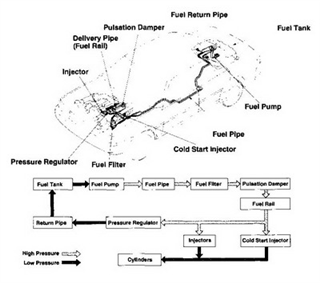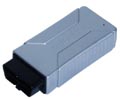- engine Fuel Supply
- |
- Fuel Inhection Overview
- |
- Fuel Injection
- |
- Repair Basics
- |
- Technical Info
- |
- Car Tech Info
- |
- MicroTronik
Types of Fuel engine supply
A conventional (flow and return) system has a supply of fuel delivered to the fuel rail, and the unwanted fuel is passed through the pressure regulator back to the tank. It is the restriction in the fuel line created by the pressure regulator that provides the system operational pressure.Returnless Fuel Systems
Have been adopted by several motor manufacturers and differ from the conventional by having a delivery pipe only to the fuel rail with no return flow back to the tank.The returnless systems, both the mechanical and the electronic versions, were necessitated by emissions laws. The absence of heated petrol returning to the fuel tank reduces the amount of evaporative emissions, while the fuel lines are kept short, thus reducing build costs.
Mechanical Returnless Fuel Systems
The (returnless) system differs from the norm by having the pressure regulator inside the fuel tank. When the fuel pump is activated, fuel flows into the system until the required pressure is obtained; at this point (excess) fuel is bled past the pressure regulator and back into the tank.The (flow and return) system has a vacuum supply to the pressure regulator: this enables the fuel pressure to be increased whenever the manifold vacuum drops, providing fuel enrichment under acceleration.
The (returnless) system has no mechanical compensation affecting the fuel pressure, which remains at a higher than usual 44 to 50 psi.
By increasing the delivery pressure, the ECM (Electronic Control Module) can alter the injection pulse width to give the precise delivery, regardless of the engine load and without fuel pressure compensation.
Electronic Returnless Fuel Systems
This version has all the required components fitted within the one unit of the submersible fuel pump. It contains a small particle filter (in addition to the strainer), pump, electronic pressure regulator, fuel level sensor and a sound isolation system. The electronic pressure regulator allows the pressure to be increased under acceleration conditions, and output of the pump can be adjusted to suit the fuel of the engine demand. This prolongs the life of the pump as it is no longer providing a larger than required output delivery.The Electronic Control Module (ECM) supplies the required pressure information, while output signal of the fuel pump is supplied in the form of a digital square wave. Altering the duty cycle of square wave affects the delivery output of the pump.
To compensate for the changing viscosity of the fuel with changing fuel temperature, a fuel rail temperature sensor is installed. A pulsation damper may also be fitted ahead of or inside the fuel rail.
AutoHex (Auto Diagnostic scanner) is one of the best Professional scan tools to for Cars; Autohex Scanner can test the Systems of the Car effectively and easily, with many powerful features to help you in diagnosing and testing.
Changing Dmaged DME in F Series
Description
We will be looking at the Electronic Fuel Injection system and engine fuel supply types
Autohex II Reviews
AutoHex II
AutoHex II is your best choice to have full access to dealer functions like coding, adjusting and modules flashing/programming, Contact us for prices
AutoHex Forum



